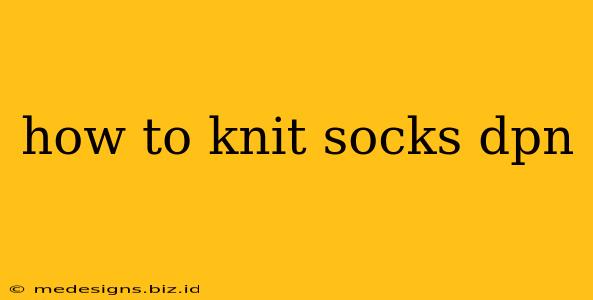Knitting socks with double-pointed needles (DPNs) is a classic technique that allows for seamless, beautifully shaped socks. While it might seem daunting at first, with a little patience and practice, you'll be creating cozy, custom-fit socks in no time. This guide will walk you through the entire process, from choosing the right materials to finishing those perfect toes.
Getting Started: Choosing Your Materials
Before you begin, gathering the right supplies is crucial for a successful sock-knitting experience.
1. Yarn:
- Fiber: Consider the season and your preferences. Merino wool is a popular choice for its softness and warmth, while cotton or linen are great for summer socks. Experiment with different blends for unique textures and properties.
- Weight: Sock yarn is typically fingering weight (also known as 1 ply, or sometimes sport weight), providing the ideal balance of durability and comfort for socks. Using a heavier weight yarn will result in bulkier socks.
- Yardage: Check your pattern for specific yardage requirements. It's always better to have a little extra yarn on hand, just in case!
2. Needles:
- Double Pointed Needles (DPNs): These are short needles with pointed tips at both ends. You’ll typically need four or five DPNs, depending on the pattern. Choose a size recommended by your yarn's label or your chosen pattern. Sizes range from 1.5mm to 3.0mm.
- Note: Some knitters prefer using two circular needles (Magic Loop method), which is an alternative technique for knitting socks.
3. Other Necessities:
- Stitch markers: Essential for keeping track of pattern repeats and increases/decreases.
- Scissors: For cutting the yarn.
- Yarn needle: For weaving in the ends.
- Measuring tape: Helpful for ensuring accurate gauge and fitting.
Mastering the Technique: Knitting with DPNs
The magic of DPNs lies in their ability to knit in the round seamlessly. Here’s a breakdown of the process.
1. Casting On:
- Cast on the required number of stitches using your preferred method (long-tail cast-on is a popular choice). Distribute the stitches evenly across your four (or five) DPNs.
2. Knitting in the Round:
- Holding the needles: Hold two needles in each hand. Knit across the stitches on one needle, then transfer the stitches to the next needle.
- Working your way around: Continue knitting around, using all four (or five) needles until you reach the end of the round. It might seem complicated at first, but it becomes second nature with practice.
3. Pattern Following:
- Reading patterns: Sock knitting patterns typically use abbreviations and special instructions. Familiarize yourself with common sock knitting terminology before starting.
4. Increases and Decreases:
- Shaping the heel and toe: Most sock patterns involve increases to shape the leg and decreases to shape the heel and toe. Pay close attention to these instructions. Accuracy here is key to a well-fitting sock.
Essential Steps: Heel and Toe Techniques
These are crucial sections of any sock pattern. Numerous variations exist.
1. The Heel:
Various methods exist, including the heel flap, short rows, and gusset heel. The chosen method will heavily depend on your chosen pattern.
2. The Toe:
Similar to the heel, several techniques exist for closing the toe. Common methods include the gradual decrease method and * Kitchener stitch*.
Finishing Your Masterpiece
After completing the toe, weave in all loose ends securely to create a polished, professional-looking sock. Block your socks gently to even out the stitches and improve their overall appearance.
Troubleshooting Common Issues
- Dropped stitches: Be mindful of how you are holding the needles to prevent dropping stitches.
- Inconsistent tension: Aim to maintain even tension throughout to prevent holes and unevenness.
- Difficulty with DPNs: Practice knitting in the round to gain proficiency.
By following this comprehensive guide, you'll be well on your way to creating beautiful and comfortable hand-knitted socks using double-pointed needles. Remember to practice and have fun – your hard work will be rewarded with warm, personalized socks perfect for any occasion.
